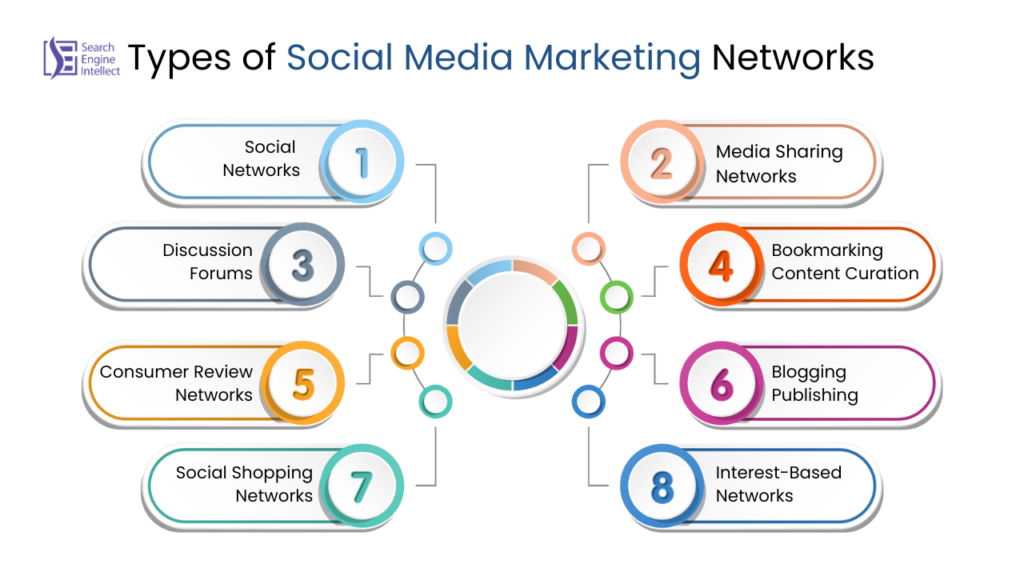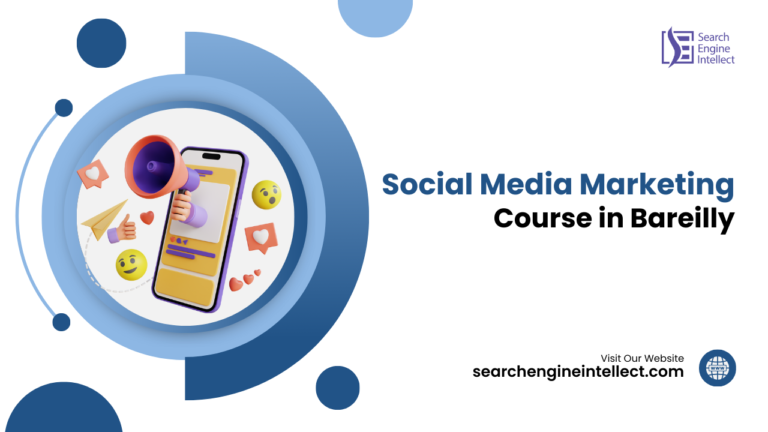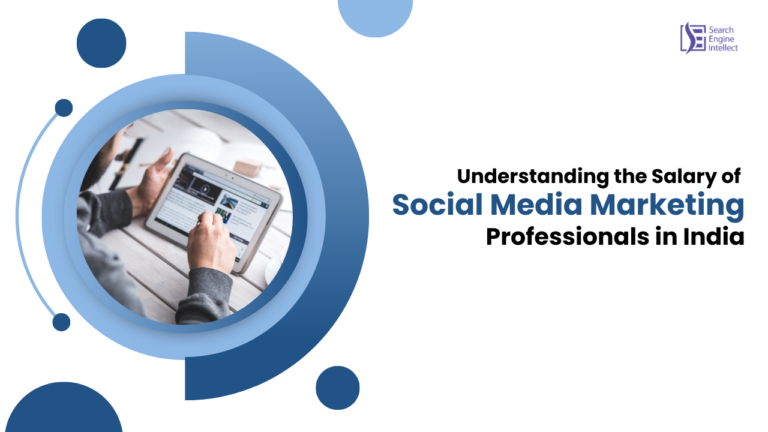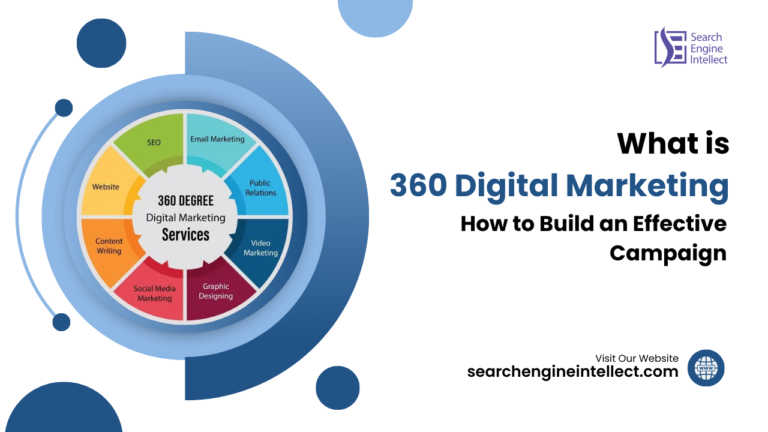Table of Contents
Book a Free Demo Class

Social Media Marketing: The Ultimate Guide
Social media marketing is an essential component of modern business strategies, leveraging various platforms to connect with audiences, enhance brand visibility, and drive sales. This guide outlines the key elements involved in effective social media marketing.
What is Social Media Marketing?
Social Media Marketing includes increasing website traffic, engagement, brand awareness, and other marketing goals by designing various types of content for different social media platforms. The material can take the form of movies, blogs, infographics, or any other format with the potential to go viral.
If done correctly, social media marketing can benefit you in various ways.
- Increase brand awareness.
- Boost conversion rates.
- Enhance search engine rankings
- Increase top-funnel traffic.
- Lower marketing campaign costs.
While the most popular networks include Facebook, Instagram, LinkedIn, YouTube, and Twitter, there are hundreds more out there. They come in a variety of flavors, including microblogging, B2B networking, video and content sharing, bookmarking, Q&A, and so on. Let’s dive a little deeper.
How does social media marketing work?
1. Define Your Goals
Establish clear objectives for your social media marketing efforts. Common goals include increasing brand awareness, generating leads, driving website traffic, and enhancing customer engagement. Goals should be SMART: Specific, Measurable, Attainable, Relevant, and Time-bound.
2. Identify Your Target Audience
Understanding your audience is crucial. Analyze demographics such as age, gender, location, interests, and online behavior to tailor your content effectively. Knowing your audience helps in creating relevant posts that resonate with them.
3. Choose the Right Platforms
Not all social media platforms are suitable for every business. Select platforms that align with your target audience and marketing goals. For instance:
- Facebook is great for community engagement.
- Instagram is ideal for visual storytelling.
- LinkedIn is best for B2B marketing.
4. Create Engaging Content
Content is at the heart of social media marketing. Develop a mix of content types to keep your audience engaged:
- Images and Videos: Visual content tends to attract more attention.
- Stories: Short-lived content can create urgency and engagement.
- User-Generated Content: Encourage customers to share their experiences with your products.
5. Develop a Content Calendar
Plan and schedule your posts in advance using a content calendar. This ensures consistency in posting and allows you to align your content with relevant events or promotions.
6. Engage with Your Audience
Social media is not just about broadcasting; it’s also about interaction. Respond to comments, messages, and mentions promptly to build relationships and trust with your audience.
7. Utilize Paid Advertising
Consider using paid ads to reach a larger or more targeted audience. Social media platforms offer robust advertising tools that allow you to define your audience based on various criteria (interests, behaviors, demographics).
8. Monitor Performance Metrics
Track the performance of your social media efforts using analytics tools provided by each platform or third-party services. Key metrics include:
- Engagement rates (likes, shares, comments)
- Follower growth
- Click-through rates (CTR)
- Conversion rates
9. Refine Your Strategy
Use the insights gained from analytics to adjust your strategy over time. Identify what works well and what doesn’t, allowing you to optimize future campaigns for better results.
Also read: Understanding the Salary of Social Media Marketing Professionals in India
Why is Social Media Marketing Useful?
Social media marketing is useful for businesses for several key reasons:
- Increased brand awareness: Social media allows you to reach a vast audience and showcase your brand, products, and services to potential customers.
- Improved customer engagement: Interacting with customers on social platforms helps build relationships and brand loyalty.
- Cost-effective advertising: Social media offers affordable advertising options to target specific audiences and achieve a higher ROI compared to traditional advertising.
- Driving website traffic: Sharing links on social media can significantly increase traffic to your website.
- Valuable customer insights: Social media provides data on audience demographics, interests, and behaviors that can inform business decisions.
- Responsive customer service: Customers expect prompt support through social channels, which can lead to positive experiences and recommendations.
- Generating leads and sales: Promoting products and services on social media can directly boost lead generation, conversions, and revenue.
In summary, social media marketing is a powerful and cost-effective way for businesses to build brand awareness, engage with customers, gather insights, provide support, and ultimately drive growth.
How to Build Your Social Media Marketing Strategy
Define Your Goals: Establish clear, measurable objectives that align with your overall business goals, such as increasing brand awareness, driving website traffic, or generating leads.
Understand Your Target Audience: Conduct thorough research to identify your target audience’s demographics, interests, and behaviors.
Choose the Right Platforms: Select social media channels that resonate with your target audience and align with your business goals.
Create Engaging Content: Develop a content strategy that aligns with your brand voice and appeals to your target audience. This can include images, videos, infographics, and blog posts.
Engage with Your Audience: Respond to comments, messages, and mentions to build relationships with your followers and show that you value their input.
Analyze and Adjust: Use social media analytics to track your performance and make data-driven decisions about your strategy. Regularly review and adjust your approach based on what’s working and what’s not.
Types of Social Media Marketing Networks

Social media marketing encompasSocial media has transformed the way businesses and individuals connect, share, and engage with one another. Understanding the various types of social media platforms available is crucial for effective marketing strategies. Here’s a comprehensive overview of the different types of social media, their functions, and how they can benefit businesses.
1. Social Networks
Examples: Facebook, Twitter, LinkedIn
Social networks are designed to facilitate connections between individuals and brands. They allow users to share information, ideas, and updates while enabling businesses to build brand awareness and engage with their audience.
Benefits:
- Foster relationships through direct interaction.
- Offer organic and paid marketing opportunities.
- Serve as platforms for customer service and lead generation.
2. Media Sharing Networks
Examples: Instagram, Snapchat, YouTube
These platforms focus on sharing visual content such as photos and videos. They are essential for brands looking to create engaging content that captures attention.
Benefits:
- Enhance brand visibility through creative media.
- Drive traffic to websites via shared content.
- Enable targeted advertising based on user interests.
3. Discussion Forums
Examples: Reddit, Quora, Digg
Discussion forums are platforms where users can ask questions, share knowledge, and engage in discussions on various topics. They serve as valuable resources for market research and community engagement.
Benefits:
- Provide insights into customer opinions and preferences.
- Help establish authority in a specific niche.
- Facilitate direct engagement with potential customers.
4. Bookmarking & Content Curation Networks
Examples: Pinterest, Flipboard
These networks allow users to discover, save, and share content from around the web. They are particularly useful for businesses looking to drive traffic through curated content.
Benefits:
- Increase website traffic by sharing engaging content.
- Enhance brand awareness through visual storytelling.
- Attract niche audiences interested in specific topics.
5. Consumer Review Networks
Examples: Yelp, Zomato, TripAdvisor
Consumer review networks enable users to share their experiences with products or services. Positive reviews can significantly enhance a brand’s credibility.
Benefits:
- Build trust through authentic customer feedback.
- Influence potential buyers with social proof.
- Provide valuable insights into customer satisfaction.
6. Blogging & Publishing Networks
Examples: WordPress, Medium, Tumblr
These platforms allow users to publish articles and blogs on various topics. They are essential for content marketing strategies aimed at educating and engaging audiences.
Benefits:
- Establish authority through informative content.
- Drive organic traffic via SEO-friendly articles.
- Create a community around shared interests.
7. Social Shopping Networks
Examples: Etsy, Polyvore
Social shopping networks combine e-commerce with social interaction, allowing users to discover and purchase products within a social context.
Benefits:
- Enhance customer engagement through interactive shopping experiences.
- Foster brand loyalty by creating community-driven shopping environments.
- Increase sales through targeted promotions.
8. Interest-Based Networks
Examples: Goodreads, Houzz
These networks connect users based on shared interests or hobbies. They are ideal for targeting niche markets effectively.
Benefits:
- Facilitate word-of-mouth marketing within niche groups.
- Engage specific audiences with tailored content.
- Build communities around particular interests or products.
Also read: What is 360 Digital Marketing and How to Build an Effective Campaign?
Benefits of Social Media Marketing
Cost-Effective Marketing: Compared to traditional advertising methods, social media marketing can be more affordable and allows for targeted campaigns that reach specific demographics
Increased Brand Awareness: Social media allows businesses to reach a vast audience, with billions of users active on various platforms daily.
Lead Generation and Sales: Engaging content can convert followers into customers, driving traffic to websites and increasing sales.
Customer Engagement: Businesses can interact directly with customers, addressing inquiries and feedback in real-time.and critical technologies will continue driving results now and in the future through whatever digital channels emerge next.
Tools for Social Media Marketing

To effectively manage and enhance your social media marketing efforts, utilizing the right tools is essential. Here’s a comprehensive overview of some of the best tools available for social media marketing in 2024, categorized by their primary functions.
1. Social Media Management Tools
These tools help you schedule posts, manage multiple accounts, and analyze performance across various platforms.
Buffer
- Features: Simple scheduling, analytics, and engagement tools.
- Best For: Small businesses looking for straightforward social media management.
- Pricing: Starts from $6/month per channel.
Hootsuite
- Features: Comprehensive dashboard for scheduling, monitoring, and analyzing social media activities.
- Best For: Businesses needing a fully-featured management experience.
- Pricing: Starts from $99/month.
Sprout Social
- Features: Unified platform for scheduling posts, engaging with followers, and detailed analytics.
- Best For: Teams managing multiple accounts who need robust reporting tools.
- Pricing: Starts from $89/month.
SocialPilot
- Features: Bulk scheduling, content curation, and performance analytics.
- Best For: Small teams and agencies managing multiple client accounts.
- Pricing: Starts from $30/month.
Sendible
- Pricing: Starts at about $29 per month
- Use: All-in-one social media management tool for agencies.
- Features: Content calendar, social listening, and detailed reporting.
2. Content Creation Tools
Creating engaging content is crucial for effective social media marketing. These tools help design graphics and videos easily.
Canva
- Features: User-friendly design platform with templates for social media posts.
- Best For: Marketers needing to create visually appealing graphics without extensive design skills.
- Pricing: Free plan available; Pro version starts at $12.95/month.
Animoto
- Features: Video creation platform with drag-and-drop functionality.
- Best For: Marketers looking to produce high-quality videos quickly.
- Pricing: Paid plans start from $9/month.
3. Analytics Tools
Understanding how your content performs is vital for refining your strategy. These tools provide insights into engagement and effectiveness.
BuzzSumo
- Features: Content discovery and performance analysis across social networks.
- Best For: Identifying trending topics and analyzing competitor strategies.
- Pricing: Paid plans start at $99/month.
Keyhole
- Features: Real-time analytics for tracking hashtags, keywords, and brand mentions.
- Best For: Brands wanting to measure their social media impact effectively.
- Pricing: Custom pricing based on needs.
4. Automation Tools
These tools streamline repetitive tasks to save time and improve efficiency in your marketing efforts.
Later
- Features: Visual content calendar for scheduling posts on Instagram and other platforms.
- Best For: Brands focusing heavily on visual content like Instagram.
- Pricing: Free plan available; paid plans start at $12.50/month.
Sendible
- Pricing: Starts at $29/month.
- Features: All-in-one tool for managing multiple clients with a unified dashboard.
- Best For: Agencies that need to handle various client accounts efficiently.
Also read: Enroll in the Best Social Media Marketing Course in Bareilly today!
Social Media Marketing for Business
Social media marketing offers numerous benefits for businesses:
Access to Customer Insights: Social media analytics provide valuable data on customer preferences and behaviors
Increased Brand Awareness: Regular engagement on social platforms helps expose your brand to new audiences.
Improved Customer Engagement: Direct interaction with customers fosters loyalty and builds community.
Cost-effective Advertising: Social media ads can be targeted to specific demographics at a lower cost compared to traditional advertising methods.
Enhanced Website Traffic: Sharing links to your website can drive significant traffic from social platforms.







